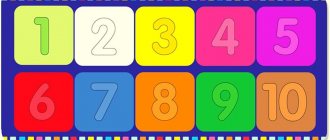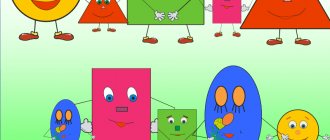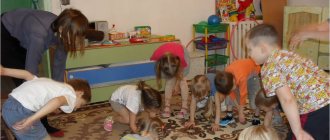“Musical interactive games in educational and musical play activities of preschool children”
Musical interactive games in educational and musical play activities of preschool children.
Muss Yulia Vladimirovna,
musical director.
Working in a modern preschool educational institution requires the music director to use new technologies aimed at effectively assimilating by children the content of educational programs in the conditions of the Federal State Educational Standard, which contributes to the formation of a person in modern society. To make educational activities more interesting and rich for a child, it is necessary to give children the opportunity to take an active part in the process of learning and creativity. In the context of informatization of preschool education, new opportunities are opening up for the development of methods and organizational forms of music education. Today it is difficult to surprise anyone with the presence of a computer, interactive whiteboard or multimedia projector in kindergarten. This technique is already becoming a necessary and indispensable means of improving the quality of the educational process. Innovations in the work of preschool educational institutions using interactive technologies increase the interest and attention of preschoolers. That is why interactive musical games on various topics can be introduced into the educational process with children.
Interactive games are an information and communication tool aimed at preschooler activities that take place online. Along with traditional teaching methods, such as the use of didactic games, multimedia interactive games allow children to become acquainted with new material with particular interest, consolidate previously learned material, and also contribute to developing children’s logical thinking in the most accessible and attractive form of play, strengthening the creative component of learning. process.
Features of interactive games:
using a variety of ways to present information
(graphics, animation, video and sound);
organization of interactive interaction between the child and the computer, providing support for independent educational and cognitive activity;
organization of group educational activities using information and communication technologies;
the use of interactive games in educational and leisure activities, in kindergarten and at home.
The interactive games presented by the teacher meet various educational and educational objectives:
development of speech activity;
development of motor activity;
knowledge of the surrounding world;
formation of creative initiative, including musical.
Musical interactive games are multimedia games, during which the student develops rhythmic hearing, musical perception, and gets acquainted with various types of musical genres, which helps enrich the child’s vocabulary with musical terms. In music classes and in leisure time, you can use computer educational and educational games aimed at a particular age of preschoolers, thereby arousing interest in this educational area and developing the creative and intellectual abilities of children. An interesting soundtrack and bright graphics open up new didactic opportunities for children related to the visualization of material, its “revitalization,” the ability to visualize those phenomena and processes that cannot be demonstrated in other ways. The advantage of musical, didactic and interactive games is that the child can independently take part in the game. Having launched the game, the preschooler completely follows its audio instructions, which will correct mistakes at the right time and reward them for successfully completing the task.
Musical and didactic games for preschool children using ICT
Milyaeva Larisa Vladimirovna
Musical and didactic games for preschool children using ICT
The main purpose of musical and didactic games is to develop musical abilities in children , in an accessible playful way to help them understand the relationship of sounds in pitch, develop their sense of rhythm, timbre and dynamic hearing, and encourage them to take independent action using the knowledge gained in music classes . Like any other game, a musical-didactic game should include the development of game actions. presented in the presentation are games that use computer technology. The didactic material is based on the tasks of developing musical perception in children ; the game action, presented in a computer interpretation, should help the child in an interesting way to hear, distinguish, compare some properties of music , and then act with them. Musical and didactic games using ICT enrich children with new impressions, develop their initiative, independence, ability to perceive, and distinguish the basic properties of musical sound . The pedagogical value of these is that they open up the way for the child to apply the acquired knowledge in life practice.
Goal: developing children's , deepening their understanding of the means of musical expression .
Tasks:
teach children to navigate in a game situation;
develop aesthetic perception, interest and love for music , emotional responsiveness and creative activity;
improve pitch, timbre, dynamic hearing, sense of rhythm and tempo, auditory attention, musical memory .
develop communication skills in the game.
Computer musical and didactic games are carried out in group, subgroup and individual musical educational activities.
Advantages of computer games:
presenting information on the screen in a playful way arouses great interest among children ;
carries a figurative type of information that is understandable to preschoolers ;
movement, sound, animation attract the child’s attention for a long time;
are a stimulus for children's ;
provide the opportunity for individual training;
in the process of independent activity at the computer, the preschooler gains self-confidence; allow you to simulate life situations that cannot be seen in everyday life.
Requirements for games using computer technology:
Children use computer no more than once a day and no more than three times a week on days of highest performance: Tuesday, Wednesday and Thursday;
After classes with children, they do eye exercises;
Continuous duration of work with a computer in classes for children under 5 years old is from 2 to 5 minutes. For children 5-6 years of age should not exceed 10 minutes and for children 6-7 years old - 15 minutes ;
the distance from the child’s eyes to the computer is at least 75 centimeters;
furniture (table and chair)
must correspond to the height of the child.
Interactive game for children of senior preschool age “Musical Pages”
This resource is intended for children of senior preschool age, but in practice we used it with children of middle preschool age and with children in the group with mental retardation.
This manual includes games and riddles aimed at consolidating knowledge on the topic “Musical Instruments” in a playful way. “Find the extra” Goal: to consolidate the ability to classify and generalize knowledge. children are offered 4 tasks, the child chooses:
Task No. 1 (trombone, flute, pipe, horn, violin) An image of musical instruments appears on the screen, the child must identify the extra instrument, when choosing the wrong answer, the child hears the phrase “Think”, and the image does not disappear, only sways. When choosing the correct answer, the child hears the praise “Well done!” and the extra tool disappears from the screen. To continue, you need to press the arrow to the right; if the child wants to return to the main page, you need to select “House”; if there is a rounded arrow on the task selection page.
“Musical chest” Purpose: to consolidate children’s knowledge of musical instruments, groups of musical instruments, to stimulate auditory attention.
Children are invited to listen to a fragment of the sound of a chosen musical instrument. It is especially interesting for a preschooler to hear the sounds of the chosen musical instrument.
Puzzles. Goal: acquaintance with musical instruments through folk art. The riddles are voiced, the child hears, guesses the riddle and sees a picture - the answer, hears the word and is sure to receive praise.
The games include animation effects, which makes it possible to improve feedback with children and provide more comfortable conditions for conducting classes and an individual approach to learning, allowing you to show the world of music much richer and brighter, and connect visual and auditory ideas.
It should also be taken into account that the duration of classes using a computer for preschool children is in accordance with the requirements of SanPiN.
cannot exceed 7-10 minutes. For the full text of the material Interactive game for children of senior preschool age “Musical Pages”, see the downloadable file
. The page contains a fragment.
| Author: Khvoina N. M., Tveritina G. G. → Publisher 08/18/2017 2 12954 2213 | Comment |
Thank you for your mark. If you want your name to be known to the author, log in to the site as a user and click Thank you again. Your name will appear on this page.
Login | Registration
Have an opinion? Leave a comment








